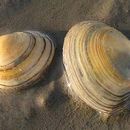Biology
provided by Arkive
This bivalve burrows into the sediment to depths of around 20 cm. When covered by the tide, it feeds by extending a tube known as the 'inhalant siphon' to the surface; a current of water passes down the siphon and into the body of the bivalve, where particles are removed. The water is then expelled via a second tube (the 'exhalant siphon'). This species feeds on matter on the surface of the sediment, and it leaves star-shaped marks where it has been feeding. Crabs and fishes often feed on the inhalant siphon when it is extended, but the damaged tissue is replaced quickly, in around 5 days (2).
Separate males and females occur, and breeding typically occurs in summer (2). The larvae are free-swimming (known as veliger larvae); they undergo metamorphosis into adults and settle after this planktonic stage, which lasts for 2 or 3 weeks (2).
Conservation
provided by Arkive
Conservation action has not been targeted at this species.
Description
provided by Arkive
The peppery furrow shell is a bivalve mollusc with a thin, flattened, rounded shell (3). The outer surface of the shell may be white, grey or yellowish, and has fine concentric lines; the inside is always white (3).
Habitat
provided by Arkive
Inhabits estuarine and intertidal areas, and can survive in conditions of low salinity in thick mud and sand (3).
Range
provided by Arkive
Found around Britain, often occurring in high densities. It is also common around north-west Europe (2).
Status
provided by Arkive
Common and widespread (2).
Threats
provided by Arkive
Not currently threatened.
Brief Summary
provided by Ecomare
Peppery furrow shells live burrowed deep in the bottom. In order to get fresh water and food, it sticks two siphons out of the bottom. They must be very long, sometimes as much as 25 centimeters. That's four times its own shell length. The siphons are not directly next to each other; otherwise it would drink the filtered water that it just ejected. Besides filtering the water for food, this species is also able to graze the surface, leaving behind typical 'sparkle-like' tracks on the bottom of the tidal flats. The siphons are an easy bite for all kinds of fish and birds.
- license
- cc-by-nc
- copyright
- Copyright Ecomare
Scrobicularia plana
provided by wikipedia EN
Scrobicularia plana, the peppery furrow shell, is a bivalve mollusc belonging to the family Semelidae.
Taxonomy
Although Scrobicularia plana is the only species currently recognized by ITIS in the genus Scrobicularia;[1] World Register of Marine Species recognises another species, Scrobicularia cottardi as well as some nomen dubia,[2] as does the BioLib.[3]
The genus Scrobicularia is sometimes placed as the sole genus in a family, Scrobicularidae. It is now often placed instead in the related family Semelidae, as shown in the infobox. However this placement may change as molecular systematics provides new insights into the cladistics of the bivalves.
Description
The shell can be anything from white through yellowish to a pale brownish-grey in colour, up to 6.5 cm in diameter. Its interior is nacreous and white or yellowish in colour. The shell is thin but quite deep, with circular closely packed growth ridges.
It is a filter feeder, with long siphons, burying itself up to 20 cm deep in sand or mud. When buried, it leaves star-shaped markings on the surface, and specimens can be found by looking for these. If the siphons are browsed by fish or other predators, they regenerate in a few days.
Right and left valve of the same specimen:
Distribution and habitat
This species is commonly found at quite high densities on sandy or muddy sea coasts and estuaries[4] in northern Europe, the Mediterranean and West Africa.
Commercial use
The peppery furrow shell is edible and can be found in some fish shops in France, where they are called lavignons.[5]
References
-
^ "Scrobicularia Schumacher, 1815". Integrated Taxonomic Information System. Retrieved 19 April 2019.
-
^ Bieler R, Bouchet P, Gofas S, Marshall B, Rosenberg G, La Perna R, Neubauer TA, Sartori AF, Schneider S, Vos C, ter Poorten JJ, Taylor J, Dijkstra H, Finn J, Bank R, Neubert E, Moretzsohn F, Faber M, Houart R, Picton B, Garcia-Alvarez O, eds. (2014). "Scrobicularia Schumacher, 1815". MolluscaBase. World Register of Marine Species. Retrieved 19 April 2019.
-
^ "Scrobicularia Schumacher, 1815". BioLib.cz. Retrieved 19 April 2019.
-
^ Green, J. (1957). "The growth of Scrobicularia plana (da Costa) in the Gwendraeth estuary" (PDF). Journal of the Marine Biological Association of the United Kingdom. 36 (1): 41–47. doi:10.1017/S0025315400017057.
-
^ "La sauce de lavignons". Keldelice (in French).

- license
- cc-by-sa-3.0
- copyright
- Wikipedia authors and editors
Scrobicularia plana: Brief Summary
provided by wikipedia EN
Scrobicularia plana, the peppery furrow shell, is a bivalve mollusc belonging to the family Semelidae.
- license
- cc-by-sa-3.0
- copyright
- Wikipedia authors and editors

